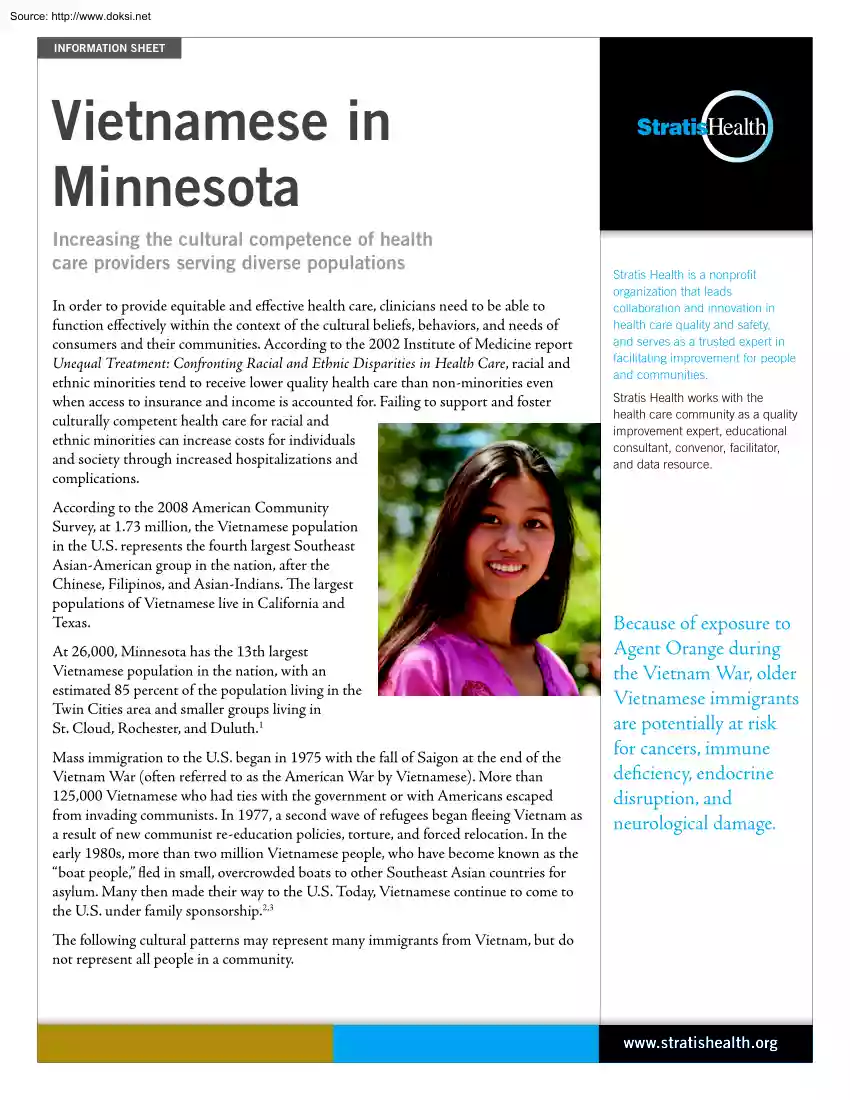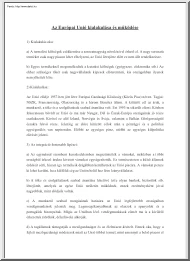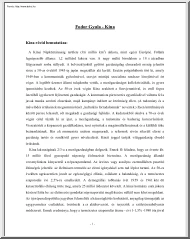Datasheet
Year, pagecount:2012, 3 page(s)
Language:English
Downloads:3
Uploaded:October 11, 2018
Size:668 KB
Institution:
-
Comments:
Attachment:-
Download in PDF:Please log in!
Comments
No comments yet. You can be the first!Most popular documents in this category
Content extract
Source: http://www.doksinet information sheet Vietnamese in Minnesota Increasing the cultural competence of health care providers serving diverse populations In order to provide equitable and effective health care, clinicians need to be able to function effectively within the context of the cultural beliefs, behaviors, and needs of consumers and their communities. According to the 2002 Institute of Medicine report Unequal Treatment: Confronting Racial and Ethnic Disparities in Health Care, racial and ethnic minorities tend to receive lower quality health care than non-minorities even when access to insurance and income is accounted for. Failing to support and foster culturally competent health care for racial and ethnic minorities can increase costs for individuals and society through increased hospitalizations and complications. According to the 2008 American Community Survey, at 1.73 million, the Vietnamese population in the U.S represents the fourth largest Southeast Asian-American
group in the nation, after the Chinese, Filipinos, and Asian-Indians. The largest populations of Vietnamese live in California and Texas. At 26,000, Minnesota has the 13th largest Vietnamese population in the nation, with an estimated 85 percent of the population living in the Twin Cities area and smaller groups living in St. Cloud, Rochester, and Duluth1 Mass immigration to the U.S began in 1975 with the fall of Saigon at the end of the Vietnam War (often referred to as the American War by Vietnamese). More than 125,000 Vietnamese who had ties with the government or with Americans escaped from invading communists. In 1977, a second wave of refugees began fleeing Vietnam as a result of new communist re-education policies, torture, and forced relocation. In the early 1980s, more than two million Vietnamese people, who have become known as the “boat people,” fled in small, overcrowded boats to other Southeast Asian countries for asylum. Many then made their way to the US Today,
Vietnamese continue to come to the U.S under family sponsorship2,3 Stratis Health is a nonprofit organization that leads collaboration and innovation in health care quality and safety, and serves as a trusted expert in facilitating improvement for people and communities. Stratis Health works with the health care community as a quality improvement expert, educational consultant, convenor, facilitator, and data resource. Because of exposure to Agent Orange during the Vietnam War, older Vietnamese immigrants are potentially at risk for cancers, immune deficiency, endocrine disruption, and neurological damage. The following cultural patterns may represent many immigrants from Vietnam, but do not represent all people in a community. www.stratishealthorg Source: http://www.doksinet Social Structure. A traditional Vietnamese family is patriarchal, with two to four generations and extended family often living in the same home. Family members are expected to work and behave for the good
of the group. Traditionally, the father has ultimate responsibility and is the head of the household, although due to Western influence gender roles now vary greatly. In the US, arranged marriages are declining. Parents today take more of an advisory role in the choice of a child’s mate. Divorce is uncommon and is considered shameful, especially for women. Vietnamese people use the family name first, then the middle name, with the first name last. Most names have a specific meaning and can be used for either gender. Diet. A typical Vietnamese diet is generally healthy, with rice or noodles, fresh vegetables, and fish or meat. However, the diet also can be high in sodium from fish sauce and MSG, and low in fiber from lack of whole grains. Dairy and soy products are not part of a typical Vietnamese diet, although most children drink milk. Many adults are lactose intolerant and lack calcium. Women generally believe that formula is more nutritious than nursing for their infants. Some
Vietnamese people do not understand that rice and traditional desserts high in sugar and saturated fats from coconut milk and oil cause weight gain and high blood sugar. In Vietnamese culture, chubby children are considered healthy and a sign of prosperity. This population may be susceptible to weight gain, high cholesterol, and diabetes. Religion. Prior to the Vietnam War, Buddhism was practiced by 90 percent of the population in Vietnam. Today, the Vietnamese practice a variety of religions. Many are Roman Catholics, a result of Vietnam’s occupation by the French, Portuguese, and Spanish. They also may worship spirits and natural forces, or practice ancestor worship or astrology. Confucianism and Taoism have strongly influenced Vietnamese cultural traditions. Many customs are rooted in both the Confucian respect for education, family, and elders, and the Taoist desire to avoid conflict. Stoicism is a highly respected trait Medical Care. Many Vietnamese had severe health problems on
arrival in the U.S from poor living conditions, starvation, and abuse during the Vietnam War and in refugee camps. Medical problems included tuberculosis, hepatitis B, malaria, malnutrition, trichinosis, anemia, leprosy, and intestinal parasites. Because of exposure to Agent Orange, older immigrants are at risk for cancers, immune deficiency, endocrine disruption, and neurological damage. The most common cancers seen are prostate, breast, lung, and colorectal cancer. Rates of smoking among men are very high with smoking-related cancer endemic in this population. In Minnesota, Vietnamese who consume large quantities of fish taken from lakes and rivers are at risk of exposure to mercury and PCBs. The Minnesota Department of Health advises clinicians to encourage their patients to replace some fish in their diet with alternative protein sources. Many Vietnamese believe that Asian people are different physiologically from white people. Western medicines are thought of as “hot” and too
potent for their physiology. They may not take medicines as prescribed. Symptoms are often attributed to a physical weakness; for example, a weak heart is expressed by panic, palpitations, and dizziness; a weak kidney is expressed by impotence; a weak stomach or liver is expressed by indigestion; and a weak nervous system is expressed by headache or lack of concentration. Often, elders do not trust Western medicine and use it only as a last resort. They may resist immunizations and invasive procedures, and view a clinician who does not intrude on the body as the best healer. Some believe a physician should be able to diagnose a problem by looking at them and feeling their pulse. Vietnamese people also believe in the medicinal properties of foods such as mung beans, green beans, and bitter melon, which is believed to help control blood pressure. Acupuncture is used widely for arthritis pain, stroke, visual problems, and other symptoms. Clinicians should be aware of dermabrasive
procedures used by Vietnamese patients that leave marks on the skinand not misinterpret the marks as signs of physical abuse. These procedures based on the Chinese philosophy of hot/cold physiology are often used to treat headache, cough, nausea, and other maladies. Cutaneous hematomas are made on the face and trunk by pinching and pulling the skin to release excessive air, by rubbing skin with a coin or spoon, or by cuppingheating air in a cup with a flame, then placing the cup on the skin. As the air cools, it contracts and pulls on the skin, leaving a purple mark. Moxibustion, often combined with acupuncture, is the process of making superficial circular burns on the skin with ignited incense or other material placed directly on the skin. In Vietnam, elders had authority and were respected, but they have lost much of this status in the U.S, leaving many www.stratishealthorg Source: http://www.doksinet depressed and lonely. However, because many believe emotional pain to be a
physical symptom, they may resist referrals to mental health clinics. Mental illness is traditionally considered a shameful thing, often feared and denied In Vietnam, the mentally ill were hidden away. Although many may suffer from anxiety, depression, and post traumatic stress disorder, they do not reveal these problems. Vietnamese patients may smile easily and often, regardless of underlying emotions. Because they value politeness and respect for authority, patients may not voice concerns or ask providers questions. If they disagree or do not understand, they may simply listen and answer “yes,” then not comply with recommendations or return for further care. Vietnamese patients may not take appointment times literally, arriving late so as not to appear overly enthusiastic.3,4,5 Death and Dying. Many Vietnamese people believe that suffering and illness are an unavoidable part of life. They feel that the length of one’s life is predetermined, and that prolonging life is futile.
When a person is dying, family members take turns at the bedside and attend the body after death. Buddhists may ask a monk or elder to pray at the bedside. The family may object to autopsy and organ donation. Arranging a proper funeral for a loved one is one of the most important things a Vietnamese person can do. It also helps the living grieve and go on with life. Death rituals provide the bereaved a chance to fulfill obligations and complete unfinished business with the deceased. Elaborate details of death rituals require extensive family and community involvement over a period of two to three years. The rituals communicate communal responsibilities and can recreate social order by conveying who will take the place of the deceased.3,4,5 Stratis Health has a long record of success in reducing health disparities among communities of color and underserved populations. Our efforts to reduce health disparities include increasing the cultural competence and effectiveness of providers
serving culturally diverse populations, improving health literacy in the community, and working with specific populations on targeted clinical conditions. Culture is essential in assessing a person’s health and well-being. Understanding a patient’s practice of cultural norms can allow providers to quickly build rapport and ensure effective patient-provider communication. Efforts to reduce health disparities must be holistic, addressing the physical, emotional, and spiritual health of individuals and families. Also important is making connections with community members and recognizing conditions in the community. Get to know your patients on an individual level. Not all patients from diverse populations conform to commonly known culture-specific behaviors, beliefs, and actions. Generalizations in this material may not apply to your patients. WWW.CULTURECARECONNECTIONORG Culture Care Connection is an online learning and resource center dedicated to supporting Minnesota’s health
care organizations in their ongoing efforts to provide culturally competent care. Funding to support Culture Care Connection has been provided by UCare. Contact us for assistance with your quality improvement and patient safety needs related to reducing health care disparities. Sources: 1 2008 American Community Survey, U.S Census, Profile America Facts, http:// www.censusgov/newsroom/releases/archives/facts for features speical editions/ cb10-ff07.html, viewed January 15, 2012 2 American Immigration Law Foundation, http://www.ailforg/awards/benefit2005/ vietnamese essay.shtml, viewed September 23, 2009 3 Understanding Vietnamese Culture, Minnesota Department of Health, http://www. health.statemnus/divs/idepc/refugee/globalbbvietpdf, viewed January 15, 2012 2901 Metro Drive, Suite 400 Bloomington, MN 55425-1525 4 Vietnamese Social Service, http://www.vssmnorg/about historyhtml, viewed January 15, 2012 (952) 854-3306 telephone Ethnomed
http://ethnomed.org/cultures/vietnamese/vietnamese cphtml, http:// ethnomed.org/ethnomed/cultures/vietnamese/vietnamese cphtml#western, viewed September 23, 2009 5 (952) 853-8503 fax 1-877-STRATIS (1-877-787-2847) toll-free info@stratishealth.org (01/12) www.stratishealthorg
group in the nation, after the Chinese, Filipinos, and Asian-Indians. The largest populations of Vietnamese live in California and Texas. At 26,000, Minnesota has the 13th largest Vietnamese population in the nation, with an estimated 85 percent of the population living in the Twin Cities area and smaller groups living in St. Cloud, Rochester, and Duluth1 Mass immigration to the U.S began in 1975 with the fall of Saigon at the end of the Vietnam War (often referred to as the American War by Vietnamese). More than 125,000 Vietnamese who had ties with the government or with Americans escaped from invading communists. In 1977, a second wave of refugees began fleeing Vietnam as a result of new communist re-education policies, torture, and forced relocation. In the early 1980s, more than two million Vietnamese people, who have become known as the “boat people,” fled in small, overcrowded boats to other Southeast Asian countries for asylum. Many then made their way to the US Today,
Vietnamese continue to come to the U.S under family sponsorship2,3 Stratis Health is a nonprofit organization that leads collaboration and innovation in health care quality and safety, and serves as a trusted expert in facilitating improvement for people and communities. Stratis Health works with the health care community as a quality improvement expert, educational consultant, convenor, facilitator, and data resource. Because of exposure to Agent Orange during the Vietnam War, older Vietnamese immigrants are potentially at risk for cancers, immune deficiency, endocrine disruption, and neurological damage. The following cultural patterns may represent many immigrants from Vietnam, but do not represent all people in a community. www.stratishealthorg Source: http://www.doksinet Social Structure. A traditional Vietnamese family is patriarchal, with two to four generations and extended family often living in the same home. Family members are expected to work and behave for the good
of the group. Traditionally, the father has ultimate responsibility and is the head of the household, although due to Western influence gender roles now vary greatly. In the US, arranged marriages are declining. Parents today take more of an advisory role in the choice of a child’s mate. Divorce is uncommon and is considered shameful, especially for women. Vietnamese people use the family name first, then the middle name, with the first name last. Most names have a specific meaning and can be used for either gender. Diet. A typical Vietnamese diet is generally healthy, with rice or noodles, fresh vegetables, and fish or meat. However, the diet also can be high in sodium from fish sauce and MSG, and low in fiber from lack of whole grains. Dairy and soy products are not part of a typical Vietnamese diet, although most children drink milk. Many adults are lactose intolerant and lack calcium. Women generally believe that formula is more nutritious than nursing for their infants. Some
Vietnamese people do not understand that rice and traditional desserts high in sugar and saturated fats from coconut milk and oil cause weight gain and high blood sugar. In Vietnamese culture, chubby children are considered healthy and a sign of prosperity. This population may be susceptible to weight gain, high cholesterol, and diabetes. Religion. Prior to the Vietnam War, Buddhism was practiced by 90 percent of the population in Vietnam. Today, the Vietnamese practice a variety of religions. Many are Roman Catholics, a result of Vietnam’s occupation by the French, Portuguese, and Spanish. They also may worship spirits and natural forces, or practice ancestor worship or astrology. Confucianism and Taoism have strongly influenced Vietnamese cultural traditions. Many customs are rooted in both the Confucian respect for education, family, and elders, and the Taoist desire to avoid conflict. Stoicism is a highly respected trait Medical Care. Many Vietnamese had severe health problems on
arrival in the U.S from poor living conditions, starvation, and abuse during the Vietnam War and in refugee camps. Medical problems included tuberculosis, hepatitis B, malaria, malnutrition, trichinosis, anemia, leprosy, and intestinal parasites. Because of exposure to Agent Orange, older immigrants are at risk for cancers, immune deficiency, endocrine disruption, and neurological damage. The most common cancers seen are prostate, breast, lung, and colorectal cancer. Rates of smoking among men are very high with smoking-related cancer endemic in this population. In Minnesota, Vietnamese who consume large quantities of fish taken from lakes and rivers are at risk of exposure to mercury and PCBs. The Minnesota Department of Health advises clinicians to encourage their patients to replace some fish in their diet with alternative protein sources. Many Vietnamese believe that Asian people are different physiologically from white people. Western medicines are thought of as “hot” and too
potent for their physiology. They may not take medicines as prescribed. Symptoms are often attributed to a physical weakness; for example, a weak heart is expressed by panic, palpitations, and dizziness; a weak kidney is expressed by impotence; a weak stomach or liver is expressed by indigestion; and a weak nervous system is expressed by headache or lack of concentration. Often, elders do not trust Western medicine and use it only as a last resort. They may resist immunizations and invasive procedures, and view a clinician who does not intrude on the body as the best healer. Some believe a physician should be able to diagnose a problem by looking at them and feeling their pulse. Vietnamese people also believe in the medicinal properties of foods such as mung beans, green beans, and bitter melon, which is believed to help control blood pressure. Acupuncture is used widely for arthritis pain, stroke, visual problems, and other symptoms. Clinicians should be aware of dermabrasive
procedures used by Vietnamese patients that leave marks on the skinand not misinterpret the marks as signs of physical abuse. These procedures based on the Chinese philosophy of hot/cold physiology are often used to treat headache, cough, nausea, and other maladies. Cutaneous hematomas are made on the face and trunk by pinching and pulling the skin to release excessive air, by rubbing skin with a coin or spoon, or by cuppingheating air in a cup with a flame, then placing the cup on the skin. As the air cools, it contracts and pulls on the skin, leaving a purple mark. Moxibustion, often combined with acupuncture, is the process of making superficial circular burns on the skin with ignited incense or other material placed directly on the skin. In Vietnam, elders had authority and were respected, but they have lost much of this status in the U.S, leaving many www.stratishealthorg Source: http://www.doksinet depressed and lonely. However, because many believe emotional pain to be a
physical symptom, they may resist referrals to mental health clinics. Mental illness is traditionally considered a shameful thing, often feared and denied In Vietnam, the mentally ill were hidden away. Although many may suffer from anxiety, depression, and post traumatic stress disorder, they do not reveal these problems. Vietnamese patients may smile easily and often, regardless of underlying emotions. Because they value politeness and respect for authority, patients may not voice concerns or ask providers questions. If they disagree or do not understand, they may simply listen and answer “yes,” then not comply with recommendations or return for further care. Vietnamese patients may not take appointment times literally, arriving late so as not to appear overly enthusiastic.3,4,5 Death and Dying. Many Vietnamese people believe that suffering and illness are an unavoidable part of life. They feel that the length of one’s life is predetermined, and that prolonging life is futile.
When a person is dying, family members take turns at the bedside and attend the body after death. Buddhists may ask a monk or elder to pray at the bedside. The family may object to autopsy and organ donation. Arranging a proper funeral for a loved one is one of the most important things a Vietnamese person can do. It also helps the living grieve and go on with life. Death rituals provide the bereaved a chance to fulfill obligations and complete unfinished business with the deceased. Elaborate details of death rituals require extensive family and community involvement over a period of two to three years. The rituals communicate communal responsibilities and can recreate social order by conveying who will take the place of the deceased.3,4,5 Stratis Health has a long record of success in reducing health disparities among communities of color and underserved populations. Our efforts to reduce health disparities include increasing the cultural competence and effectiveness of providers
serving culturally diverse populations, improving health literacy in the community, and working with specific populations on targeted clinical conditions. Culture is essential in assessing a person’s health and well-being. Understanding a patient’s practice of cultural norms can allow providers to quickly build rapport and ensure effective patient-provider communication. Efforts to reduce health disparities must be holistic, addressing the physical, emotional, and spiritual health of individuals and families. Also important is making connections with community members and recognizing conditions in the community. Get to know your patients on an individual level. Not all patients from diverse populations conform to commonly known culture-specific behaviors, beliefs, and actions. Generalizations in this material may not apply to your patients. WWW.CULTURECARECONNECTIONORG Culture Care Connection is an online learning and resource center dedicated to supporting Minnesota’s health
care organizations in their ongoing efforts to provide culturally competent care. Funding to support Culture Care Connection has been provided by UCare. Contact us for assistance with your quality improvement and patient safety needs related to reducing health care disparities. Sources: 1 2008 American Community Survey, U.S Census, Profile America Facts, http:// www.censusgov/newsroom/releases/archives/facts for features speical editions/ cb10-ff07.html, viewed January 15, 2012 2 American Immigration Law Foundation, http://www.ailforg/awards/benefit2005/ vietnamese essay.shtml, viewed September 23, 2009 3 Understanding Vietnamese Culture, Minnesota Department of Health, http://www. health.statemnus/divs/idepc/refugee/globalbbvietpdf, viewed January 15, 2012 2901 Metro Drive, Suite 400 Bloomington, MN 55425-1525 4 Vietnamese Social Service, http://www.vssmnorg/about historyhtml, viewed January 15, 2012 (952) 854-3306 telephone Ethnomed
http://ethnomed.org/cultures/vietnamese/vietnamese cphtml, http:// ethnomed.org/ethnomed/cultures/vietnamese/vietnamese cphtml#western, viewed September 23, 2009 5 (952) 853-8503 fax 1-877-STRATIS (1-877-787-2847) toll-free info@stratishealth.org (01/12) www.stratishealthorg





 Just like you draw up a plan when you’re going to war, building a house, or even going on vacation, you need to draw up a plan for your business. This tutorial will help you to clearly see where you are and make it possible to understand where you’re going.
Just like you draw up a plan when you’re going to war, building a house, or even going on vacation, you need to draw up a plan for your business. This tutorial will help you to clearly see where you are and make it possible to understand where you’re going.